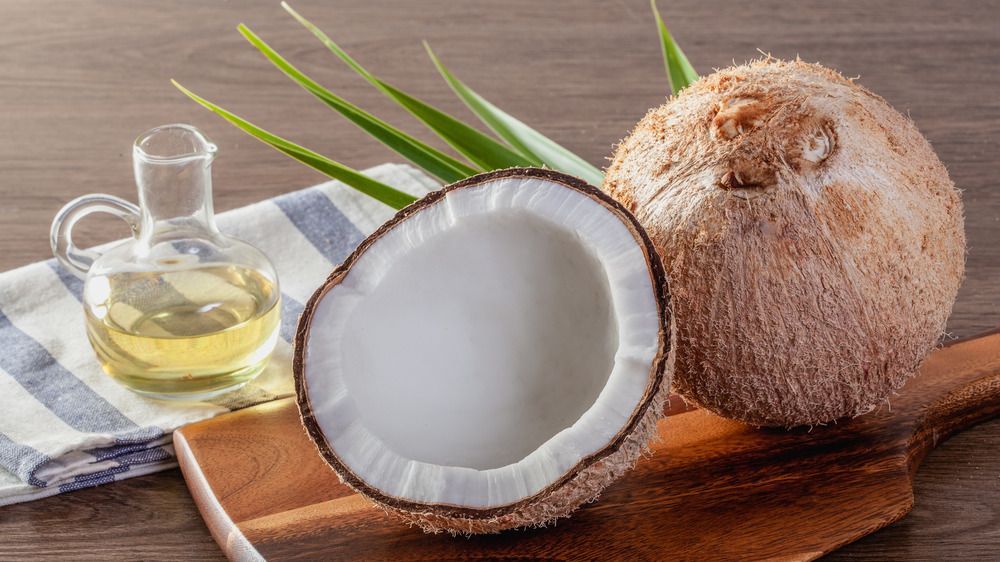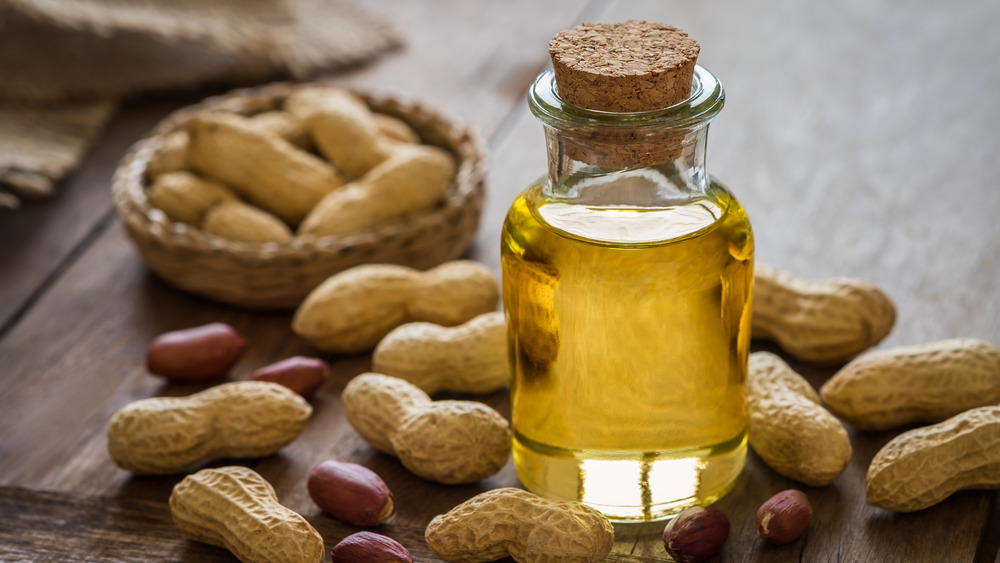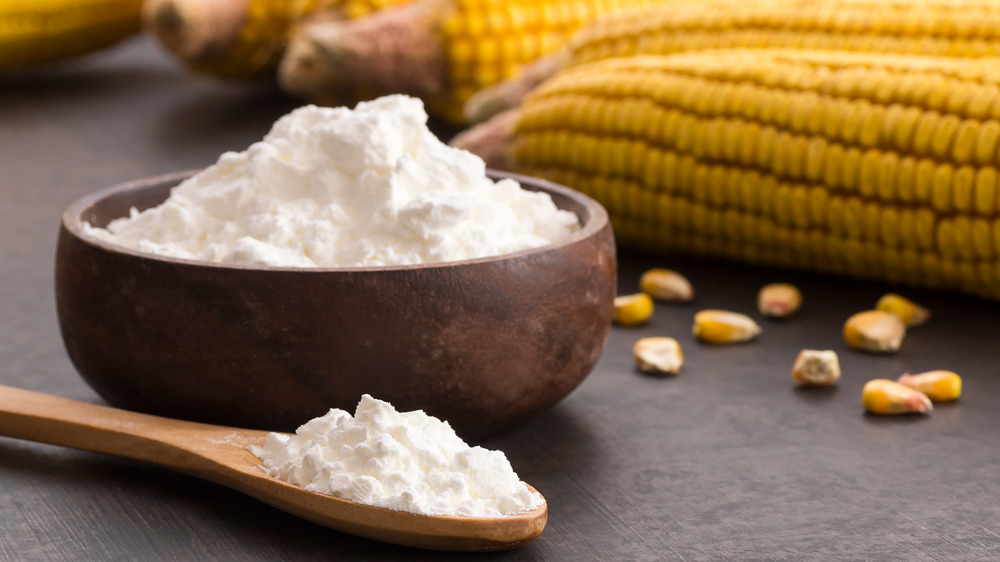Unhealthy Ingredients To Watch Out For In Your Food
Reviewing ingredients on a nutrition label can be a frustrating, head-spinning task — especially once you consider your individual health needs and the ever-changing information about what is "good" and "bad" for you. And complexity isn't the only thing working against you.
According to Harvard's Healthbeat, inertia is a big obstacle to starting healthy habits. For example, imagine you learn an ingredient in your cereal is unhealthy. Finding a new cereal could mean checking dozens of food labels or combing through tons of information online. It's often easier to stick with the unhealthy cereal and your well-established grocery shopping routine.
Feeling discouraged is understandable, but there are some helpful things to keep in mind. First, nutrition isn't like a math problem, in which if you eat x, then y will always happen. Instead, you're more likely to find evidence suggesting that if you eat x, then y could happen. It's up to you and your health care professional to decide how likely it is that y could happen to you. And second, it's not only what foods you eat, but how often you eat them, their size, and how they're prepared that can make them unhealthy.
Processed fruit juices lack important fiber
Wait, isn't fruit healthy? Yes, but with processed fruit juice, manufacturers remove nutrients like fiber (via Medical News Today). This helps increase its shelf life, as a 2015 report in Advances in Nutrition illustrated. However, removing the fiber means the body will process the fruit juice's sugar at a different rate than it would a piece of fruit.
Think of it this way: When you take vitamin B12 as part of a multivitamin gummy versus as a liquid that only contains B12, the body will process liquid with just one vitamin faster than a gummy where it has to digest the other vitamins and minerals, as well as the ingredients that make up the gummy itself. Just as the other parts of the gummy slow down how rapidly the B12 gets into your system, the fiber in fruit slows down how quickly your body processes the fruit's sugar.
So, if a product advertises using fruit juice instead of sugar or syrups, remember, how that fruit juice is processed makes a big difference. On the bright side, juicing your own fruit can be a healthy alternative to some store-bought brands (via Medical News Today).
Coconut oil is high in saturated fat
For a while coconut oil looked like the next big thing, but according to an advisory from the American Heart Association (AHA), the popular oil is 82 percent saturated fat. The advisory also noted that opting for healthy fats over saturated fats can reduce the risk of cardiovascular disease.
To be fair, all oils have saturated fat to varying degrees, according to the AHA. Canola oil, for example, has 7 percent saturated fat. But how much you consume can make a big difference, and the gap between canola's 7 percent and coconut oil's 82 percent is notable. In fact, studies have found coconut oil increases what's known as "bad" cholesterol (LDL cholesterol) to the same extent as other more widely known culprits like beef fat and butter (via AHA).
Reading food labels is important because advertising an ingredient like coconut oil doesn't mean it's your healthiest option. And for the chefs out there, the lead author of the advisory, Dr. Frank Sacks, recommends using oil made from soybeans, corn, or canola, as well as good old extra virgin olive oil, to reduce the saturated fats in your diet.
Palm oil may lead to the hardening of your arteries
Arguably, palm oil is a healthier choice than coconut oil. While still dense, this versatile oil is roughly 34 percent saturated fat (via WebMD). And because it has antioxidants, it may have some benefits like supporting good brain and heart health. But that doesn't mean there aren't possible health risks, and this is where things get a bit contradictory.
As WebMD noted, some studies point to palm oil lowering "bad" cholesterol, but there are also studies that say the oil increases its levels. The latter found other oils, like olive oil, performed better than palm oil when it came to cholesterol. Beyond these studies, research has found that reheating palm oil changes its composition enough that rather than being possibly beneficial to your heart, it might make you more likely to have atherosclerosis, or hardening of the arteries, which is defined by plaque buildup within the arteries.
So, is palm oil healthy or unhealthy? Well, while it's not as high in saturated fat as some oils, there are still far healthier options out there, including olive and canola oil. And if you have high cholesterol, you'll want to track just how much palm oil you're consuming.
Eating refined white flour can contribute to diabetes
Usually the word "refined" conjures up images of something sophisticated, reaching a level of perfection. But when it comes to flour, its "unrefined" form is the more perfect version for good health. As Medical News Today noted, creating white flour means removing the bran and the germ from its grains. While this increases the shelf life of breads and other products made from white flour, it also means you're not getting all those positive vitamins and minerals (not to mention fiber).
Seeing as this caused nutritional deficiencies, manufacturers began artificially adding the nutrients back into white flour, and enriched flour was born (via Medical News Today). So, problem solved, right? Well, it would be great if it were that simple, but we humans tend to take in the nutrients from natural sources better than processed ones.
Medical News Today explained that eating too much white bread can be very bad for your health since it has been shown to contribute to health issues like diabetes, obesity, and heart disease. While choosing other flours, like whole grain, can be a healthier option, you'll still want to monitor your intake as they can also have added salt, sugar, and preservatives, depending on the brand.
Maltodextrin can spike blood sugar levels
In all likelihood you eat maltodextrin more often than you think. This additive made from processed starchy foods is in everything from baked goods to sports drinks (via Medical News Today). Why? Because it's been shown to improve a product's shelf life, as well as its flavor and texture. Considering its widespread use, and the fact that the U.S. Food and Drug Administration recognizes it as "safe," maltodextrin can't be that bad for you, right? Not so fast.
According to Medical News Today, the glycemic index of maltodextrin is even higher than that of table sugar. The glycemic index is, basically, how much and fast a food raises your blood sugar levels. So maltodextrin spikes your blood sugar more than actual table sugar. As you can imagine, this makes it not the healthiest choice for someone who has diabetes or is insulin resistant, the publication revealed.
Want to reduce the maltodextrin in your diet? Cutting out processed foods is a sure bet. Or, you can choose sugar alcohols, like erythritol and sorbitol, over maltodextrin since they have less of an impact on your blood sugar (via Medical News Today).
TBHQ has been linked with ADHD
Tertiary butylhydroquinone, or TBHQ, is an additive used to extend the shelf life of foods (via Healthline). Commonly found in other ingredients like animal fats and vegetable oils, TBHQ shows up in frozen foods, snack crackers, and that quick, drive-thru meal. But the FDA does limit the amount of TBHQ to no more than 0.02 percent of the oils in foods. Now in all fairness, that cap is not because higher amounts are definitely hazardous (via Healthline). It's more that 0.02 percent is the highest level that has been determined as safe at this time. But even with these regulations, there are health concerns about TBHQ.
As Healthline revealed, there have been reported cases of "vision disturbances" connected with the consumption of the additive. And the Feingold Diet, which is used to help manage Attention Deficit Hyperactivity Disorder (ADHD), recommends not eating TBHQ as it may exacerbate symptoms.
Tertiary butylhydroquinone can show up on food labels as butylated hydroxyanisol, tert-butylhydroquinone, and TBHQ. And one more thing to keep in mind: BHA (butylated hydroxyanisole), another food additive on the Feingold Diet's "do not consume" list, increases the TBHQ in your body when it is metabolized.
Peanut oil is linked to heart disease
Peanut oil has high levels of unsaturated fats, according to WebMD. However, it also contains antioxidants, which means the oil can be beneficial for your health and may help lower cholesterol, regulate blood sugar, and, yes, despite the title of this section, lower the risk of heart disease. But there's a catch.
Peanut oil also contains omega-6 fatty acids. Consume too much of it, and suddenly it goes from reducing your chances of developing heart disease to increasing it. And as WebMD explained, Americans are already getting omega-6 fats from things like vegetable oil and processed foods, making it even more important to not overdo your peanut oil intake.
Although some food labels are very careful to say if an item contains peanuts, you should know that peanut oil can be listed as "groundnut oil" (via WebMD). And for anyone with a peanut allergy, you may want to talk with your health care provider to determine if refined peanut oil could be a safer option for you.
Memory loss? Too much brominated vegetable oil may be to blame
The first thing you think of when you hear "vegetable oil" is probably not soda, but if you're soft drink's ingredients includes BVO, then you've been drinking brominated vegetable oil (via Mayo Clinic). This additive has been banned in Europe but, as of this writing, is still allowed in small amounts in the United States while the FDA continues to conduct toxicology studies. And since it helps keep citrus flavoring from separating out in drinks, it can be found in other beverages besides sodas.
As the Mayo Clinic explained, BVO contains bromine, which can irritate the mucous membranes in your nose, stomach, lungs, and mouth. Over a long period of time, bromine can cause impaired balance and headaches. And reports have shown consuming more than 2 liters per day of soda that has BVO can lead to memory loss, as well as nerve problems and skin issues.
While you likely do not drink 2 liters of soda in a day, you'll still want to watch your intake. Evidence suggests bromine may accumulate in the body (via Mayo Clinic). So cutting back on products that use this ingredient in the short term, may help you in the long term.
You'll want to skip the cornstarch if you're watching your blood sugar
Cornstarch is a versatile ingredient for chefs and food manufacturers alike. It can make vegetables crispier and fruity pie fillings less runny (via Healthline). You've perhaps used it to thicken up turkey gravy on Thanksgiving or added it to a sauce to firm it up a little. Pure cornstarch is useful and gluten free. So what's not to like?
Unfortunately, as Healthline noted, cornstarch is a "refined starch," which means it lacks fiber and protein as well as vitamins and minerals. And just like with processed fruit juice, removing the fiber from cornstarch can be bad for your blood sugar. Its high carb content and lack of fiber gives it a high glycemic index, so it can cause blood sugar spikes. Plus, evidence suggests that eating foods with a high glycemic index could make you more likely to develop high blood pressure and coronary heart disease (via Healthline).
While more research needs to be done on cornstarch's role in heart health, if you have type 2 diabetes or prediabetes, you may want to cut back on your cornstarch intake, according to Healthline. Healthier alternatives include arrowroot and wheat flour.
Is MSG giving you headaches?
No collection of unhealthy ingredients list would be complete without one of the most controversial food additives: monosodium glutamate (MSG). It can increase the savory taste in certain foods, and yet it's also been connected to a wide array of health problems (via Healthline). No doubt, you've seen restaurants advertise when they don't use it, but is it really bad for you or is this more of an urban legend?
Healthline explained that MSG is derived from glutamic acid, which functions as an "excitatory neurotransmitter". Simply put, glutamic acid stimulates the nerves in your brain, so the concern is MSG increases the levels of this neurotransmitter to the point that your nerves are overly stimulated. However, eating MSG in normal amounts should not affect your brain, or have very little impact.
But then why do people complain about headaches, flushing, muscle tightness, and even numbness when they eat MSG? It's thought that certain people have a sensitivity to the additive, so avoiding it the same way someone avoids a food they are allergic to is better for their overall health.
There are connections between cancer and sodium nitrite
If you had bacon this morning for breakfast, chances are you consumed sodium nitrite (via Healthline). This additive is used in many processed meats, and on the surface, that makes sense. It keeps bacteria from forming. It adds a complimentary salty taste. It even gives the meats a pleasing color. But apologies, bacon lovers, there is a possible health risk.
According to Healthline, nitrites can be chemically transformed by high heat and amino acids into nitrosamine, which can cause health issues. One 2011 study in PLOS One found eating red and processed meats could increase a person's chances of colorectal cancer, while a study in 2017 meta-analysis in the European Journal of Cancer found processed meats could increase the risk of breast cancer. And as Healthline explained, other studies have shown links between processed meat and stomach and bladder cancers.
Is any of this a guarantee you'll have an issue with nitrites? No, but this doesn't mean it's a bad idea to cut back on foods with nitrites, like hotdogs, ham, and sausage. Healthier alternatives that are still packed with protein include chicken, eggs, nuts, fish, and beef.
Butter can lead to a heart attack or stroke
For many, butter is a bit of a guilty pleasure. Whether you add it to mashed potatoes, use it as the "secret" ingredient in your baking, or buy popcorn flavored with real butter, we often write off butter as a minor indulgence. After all, we only have a small amount of it at a time, and what's a little pat of it on a piece of toast?
Well, the American Heart Association (AHA) advises saturated fats should make up no more than 6 percent of the total caloric intake of those trying to lower their "bad" or LDL cholesterol. In other words, if you consume 2,000 calories per day, then you should not eat more than 11 to 13 grams of saturated fat. This is bad news for butter lovers, as a single tablespoon of unsalted butter has 7.2 grams of saturated fat (via Medical News Today). However, limiting your butter intake can surely benefit your health, helping you to lower your cholesterol and thus avoid a heart attack and stroke (via AHA).
Will eating butter definitely raise your cholesterol? There is some debate, but the AHA does recommend keeping track of how much butter you consume, as well as substituting it with avocado and olive oil, which are low in saturated fats.
Your margarine may contain cholesterol-raising trans fat
If you want to eat less butter, you may be thinking of getting to know its distant cousin, margarine. While butter is made from animal fat, margarine comes from vegetable oils (via Mayo Clinic). Because of this, margarine has unsaturated fats. Swapping out foods with saturated fat for ones with unsaturated fat can help lower LDL cholesterol. But you should know one thing before reaching for margarine instead of butter in the dairy aisle.
Although the FDA banned the use of artificial trans fats of over 0.5 grams per serving, the Mayo Clinic noted in 2020 that some margarines continue to contain trans fat, which can raise "bad" (LDL) cholesterol while simultaneously lowering "good" (HDL) cholesterol. And higher bad cholesterol increases your chances of developing heart disease.
As the Mayo Clinic explained, typically the more solid the margarine, the higher the amount of trans fat. So, next time you're shopping, you might want to steer clear of the sticks of margarine. And, of course, if a product is made with margarine, check its trans fat content.
Carrageenan may be causing your irritable bowel syndrome
You'd be forgiven if you've never heard of carrageenan, but you'd be surprised how many foods contain this additive. Chocolate milk, deli meats, ice cream, cottage cheese, various dairy alternatives , and even pet food are all common places to find carrageenan (via Healthline). It not only thickens and preserves foods but also helps ingredients blend well together.
Despite its usefulness, however, carrageenan has been the subject of controversy for decades. There has been evidence to suggest that it may lead to irritable bowel syndrome, bloating, colon cancer, and an intolerance to glucose (via Healthline). It may also cause inflammation that can increase the chances of health issues like arthritis, tendonitis, inflammatory bowel disease, and a type of inflammation of the gallbladder called chronic cholecystitis.
Although there are non-carrageenan options on the market, Healthline noted that the ingredients in some of them may separate without the carrageenan to hold them together. This just means you'll want to give them a good shake before pouring.















